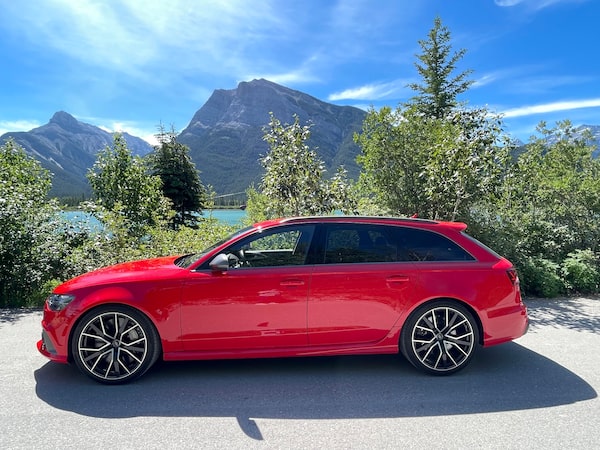
Every generation of Audi RS wagon near Banff, Alta.sagmeister_potography/Handout
This is an underdog story, but it didn’t need to be. Audi Sport might have been a household name right now, up there with rival German hot-rodders at Mercedes-AMG and the drift-happy maniacs at BMW’s M division, if not for the fact Audi kept many of its hottest cars out of North America for decades.
The result is that the company’s in-house performance-car brand – formerly known as Quattro, now Audi Sport GmbH – has some catching up to do it if is to become as big and well known as its highly profitable rivals, at least here in Canada and the United States.
All of which is to explain why we find ourselves driving what must be the only twin-turbo V10-powered Audi sedan in the whole country right now. This car, the 2010 RS 6, was never sold in Canada, but Audi Sport raided its museum in Ingolstadt, Germany to ship this and every other generation of the RS 6 to this country. Ostensibly, the idea was to mark the 20th anniversary of Audi Sport’s mid-size RS 6 sedan and station wagon, but the brand’s broader mission is to drum up awareness and show that it too, like M and AMG, has a long history of making wickedly fast luxury cars.
Cruising through the Rocky Mountains along the scenic Icefields Parkway, the 2010 RS 6 is sublime. (All Audi Sport models apart from the R8 supercar wear the RS badge.) The car is still perfectly comfortable and rapid despite its age. Torque from the twin-turbo 5.0-litre V10 peaks just above idle, delivering a hefty initial shove before the car continues accelerating until – surprise – this 12-year-old sedan is pushing you firmly back into the seat as the gigantic engine lunges for the redline.
Inside, the cabin’s cognac-coloured leather seats smell rich and feel softer than the hide in newer Audis. This car may look as exciting as a boxy grey suit, but that’s part of its appeal. Most people would never guess this understated old German family car makes 571 horsepower, more than a Lamborghini Gallardo in its day.

Interior of the first-generation Audi RS 6 Avant wagon.

Interior of the current generation Audi RS 6 Avant wagon.Handout
Back in 2010, BMW’s M5 sedan also had a V10 engine, albeit with no turbochargers and far less power. The Audi is certainly more comfortable and benefits from all-wheel drive, but its steering is slightly inert and its engine more muted than what I remember of the boisterous rear-drive M5.
Getting out of the V10 Audi and into the first-ever RS 6 Avant, launched in 2002, the older model feels smaller and lighter, but with a similarly approachable character. The 444-horsepower twin-turbo V8, co-developed with British automotive engineering specialist Cosworth, is no less impressive than the V10 and perhaps even more sonorous. Provided you have some discs to put in the six-CD changer, and you aren’t worried about old-Audi maintenance costs, this 20-year-old car would make a great daily commuter.
“[Audi Sport’s] focus is on combining track ability in a daily-driving car, an easy-to-drive car, a car that can really be used by everybody,” says Stephan Reil, the engineer who led the development of every RS car from 1998 to 2018. (The 2010 RS 6 sedan seen here is his old company car.) Reil has since moved on to another job within Audi, but he was instrumental in defining the brand.
A better way to illustrate Audi Sport’s focus – rather than transporting old cars from Germany for a handful of writers to drive – would have been to sell these fast Audis in North America in the first place. The list of RS models never offered here is long, and includes the 1994 RS 2 Avant (read: station wagon), the 2000 RS 4 Avant, the 2008 RS 6 Avant and sedan, the 2009 TT RS roadster, the 2011 and 2015 RS 3 Sportback hot hatchbacks, the 2013 and 2020 RS Q3 SUVs and many more. Meanwhile, BMW has consistently put every generation of compact M3 and mid-size M5 in Canadian showrooms since the late 1980s.

First-generation Audi RS 6 Avant wagon with a Nokia carphone.

First-generation Audi RS 6 Avant wagon with a CD changer.Matt Bubbers/The Globe and Mail
Reil says it wouldn’t have been profitable to bring all those niche RS cars to North America over the decades. Each model was typically in production for only two or three years, so it didn’t make financial sense to crash-test and certify them for North America. (Audi may have been right; the first-generation M3 was a sales flop in America.)
Today, however, Audi has seen that enough North American drivers are willing to part with great sums of money in order to drive an RS car, even if it’s not your typical sporty SUV.
Consider, for example, the unlikely success of the 2019 RS 6 Avant station wagon, a model line that’s been around since 2002 but is only now being sold in North America for the first time. Company officials won’t say how many have been sold to date, but did say the number exceeded expectations and that Canada is among the top five markets in the world for the new RS 6 Avant.
Unlike older RS 6s, the latest one is anything but understated. It looks mean, but retains its predecessors’ everyday comfort and usability. In short, it is a $126,500 chariot for wealthy parents who have a serious need for speed, but don’t want an SUV like everyone else. It’s a small niche, to be sure, but a profitable one apparently.

First-generation Audi RS 6 Avant wagon.

Second-generation Audi RS wagon.

Third-generation Audi RS 6 wagon.Matt Bubbers/The Globe and Mail
“The RS 6 Avant is really the first step to making the portfolio wider, so you have more different models in Canada and the U.S., which raises sales volume, the image and brand awareness,” Reil says after our drive.
“What Audi is doing at Audi Sport GmbH, of course, helps the image and positioning of Audi, the same as our competition: BMW M pushes the brand BMW, and AMG pushes the brand Mercedes,” he adds.
Audi Sport’s global sales reached a record high in 2021, growing 34 per cent over 2020 to 39,356 vehicles. Canadian sales figures aren’t available, but in the United States, the sub-brand delivered a record 7,796 vehicles last year.
Despite recent growth, Audi Sport is nevertheless dwarfed by BMW M and Mercedes-AMG, which delivered 163,542 and 145,979 vehicles respectively last year. (Take those totals with a grain of salt; AMG and M sales figures include less-expensive mid-range cars like BMW’s M440i and AMG’s 43 line, whereas Audi’s do not.)
Working in Audi’s favour is the fact that rarity is a plus in the luxury market. Where AMG saturates showrooms with 20 different models in Canada, Audi Sport only offers eight, but more are on the way.
The compact new RS 3 sedan should arrive in showrooms eventually, and there’s a chance the RS Q3 might finally land in Canada. Further into the future, plug-in hybrids and more all-electric RS vehicles are in the works too. Audi Sport is still an underdog in this country, but now at least it’s working hard to catch up.

sagmeister_potography/Handout
The writer was a guest of the automaker. Content was not subject to approval.
Shopping for a new car? Check out the new Globe Drive Build and Price Tool to see the latest discounts, rebates and rates on new cars, trucks and SUVs. Click here to get your price.
 Matt Bubbers
Matt Bubbers